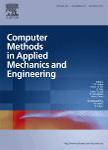版权所有:内蒙古大学图书馆 技术提供:维普资讯• 智图
内蒙古自治区呼和浩特市赛罕区大学西街235号 邮编: 010021

作者机构:Polytech Univ Dept Mech Engn Brooklyn NY 11201 USA Northwestern Univ Dept Engn Mech Evanston IL 60208 USA
出 版 物:《COMPUTER METHODS IN APPLIED MECHANICS AND ENGINEERING》 (应用力学和工程技术中的计算机方法)
年 卷 期:2004年第193卷第12-14期
页 面:1305-1321页
核心收录:
学科分类:08[工学] 0701[理学-数学] 0801[工学-力学(可授工学、理学学位)]
主 题:extended immersed boundary method immersed boundary method finite element method reproducing kernel particle method meshfree method fluid-structure interaction biofluid particulate flow
摘 要:The proposed extended immersed boundary method (EIBM) has several distinct features in comparison with the immersed boundary (IB) method. In the IB method, the interaction between the immersed elastic boundary and the surrounding viscous fluid is replaced with an equivalent body force distribution within the fluid domain. The key ingredient of the IB method is the enforcement of the energy input from the equivalent body force into the fluid domain to be the same (at all time) as that of the elastic forces within the IB. In EIBM, instead of the volumeless immersed elastic boundary, we consider the submerged elastic solid which occupies a finite volume within the fluid domain. In particular, we replace the kinematic and dynamic matching of the fluid-solid interface and the effect of the submerged solid with a judiciously chosen collection of equivalent nodal forces calculated in the context of finite element formulations. The employment of the finite element representation enables a realistic stress analysis for the submerged solid subject to large deformations. Finally, in EIBM, we also replace the discretized delta function commonly used in the IB method with the kernel functions in meshless reproducing kernel particle method (RKPM). With this improvement, using the same finite support domain, we could improve the discretized delta function from C-1 to C-n continuity, where n is chosen according to the required smoothness and resolution of such functions, and more importantly, enables the use of non-uniform meshing in the fluid domain. These extensions may eventually open doors to the modelling of complex biological fluid involving molecular, cellular, and flexible vessel-flow interactions. (C) 2004 Elsevier B.V. All rights reserved.